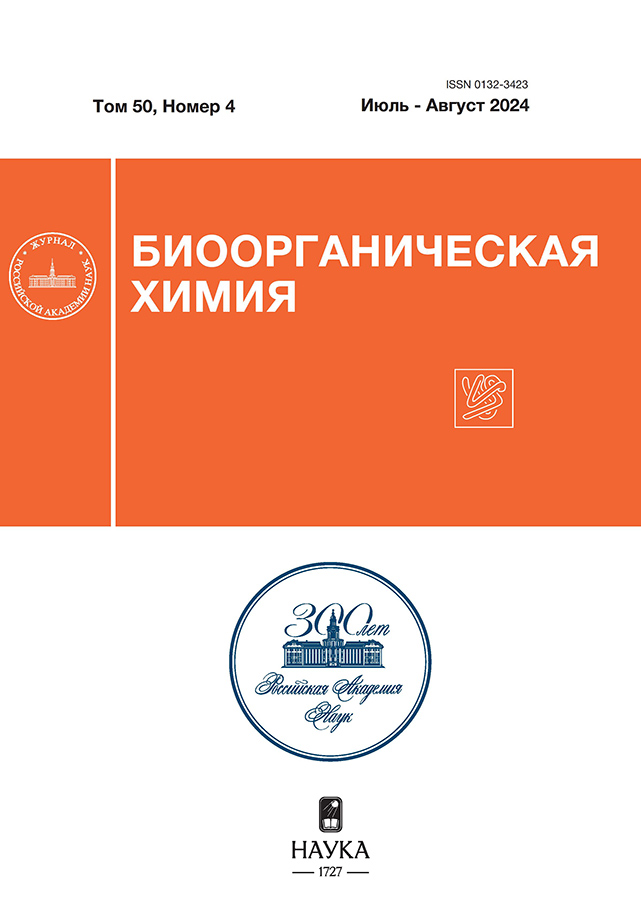Photocleavable Guide RNA for Photocontrolable CRISPR/Cas9 System
- Authors: Akhmetova E.A.1, Vokhtancev I.P.1,2, Meschaninova M.I.1, Vorobyeva M.A.1, Zharvov D.O.1,2, Novopashina D.S.1,2
-
Affiliations:
- Institute of Chemical Biology and Fundamental Medicine SB RAS
- Novosibirsk State University
- Issue: Vol 50, No 4 (2024)
- Pages: 556-567
- Section: Articles
- URL: https://cardiosomatics.ru/0132-3423/article/view/670863
- DOI: https://doi.org/10.31857/S0132342324040147
- EDN: https://elibrary.ru/MWHLXY
- ID: 670863
Cite item
Abstract
The development of gene editing systems on the base of CRISPR/Cas having higher efficacy, specificity, and possibility of their activity regulation by light irradiation is actually problem. Modification of CRISPR/Cas components, in particular guide RNA, by introduction of photocleavable linkers is the prospective approach for the solution of this problem. We developed the approach for the synthesis of photocleavable guide sgRNA for the CRISPR/Cas9 system containing the linkers on the base of 1-(2-nitrophenyl)-1,2-ethanediol. Such photomodified guide RNAs degrade upon UV-irradiation and CRISPR/Cas9 system is inactivated. We obtained three variants of photomodified sgRNA with different photolinker positions. It was demonstrated that sgRNA variant with photolinker introduced in the Cas9 protein binding and hairpins formation region is able to effectively guide Cas9 nuclease for DNA-target cleavage before UV-irradiation and lose its activity after irradiation. The conditions of controllable 40%-cleavage of model DNA-target were chosen. Developed approach provide specific inactivation of CRISPR/Cas9 gene editing system in specific time moment in definite place. Photoregulation of gene editing system permits not only reduce the undesirable off-target effects, but also becomes the basis of genetic disease therapy.
Full Text
About the authors
E. A. Akhmetova
Institute of Chemical Biology and Fundamental Medicine SB RAS
Email: danov@niboch.nsc.ru
Russian Federation, prosp. acad. Lavrentjeva 8, Novosibirsk, 630090
I. P. Vokhtancev
Institute of Chemical Biology and Fundamental Medicine SB RAS; Novosibirsk State University
Email: danov@niboch.nsc.ru
Russian Federation, prosp. acad. Lavrentjeva 8, Novosibirsk, 630090; ul. Pirogova 1, Novosibirsk, 630090
M. I. Meschaninova
Institute of Chemical Biology and Fundamental Medicine SB RAS
Email: danov@niboch.nsc.ru
Russian Federation, prosp. acad. Lavrentjeva 8, Novosibirsk, 630090
M. A. Vorobyeva
Institute of Chemical Biology and Fundamental Medicine SB RAS
Email: danov@niboch.nsc.ru
Russian Federation, prosp. acad. Lavrentjeva 8, Novosibirsk, 630090
D. O. Zharvov
Institute of Chemical Biology and Fundamental Medicine SB RAS; Novosibirsk State University
Email: danov@niboch.nsc.ru
Russian Federation, prosp. acad. Lavrentjeva 8, Novosibirsk, 630090; ul. Pirogova 1, Novosibirsk, 630090
D. S. Novopashina
Institute of Chemical Biology and Fundamental Medicine SB RAS; Novosibirsk State University
Author for correspondence.
Email: danov@niboch.nsc.ru
Russian Federation, prosp. acad. Lavrentjeva 8, Novosibirsk, 630090; ul. Pirogova 1, Novosibirsk, 630090
References
- Wang J.Y., Pausch P., Doudna J.A. // Nat. Rev. Microbiol. 2022. V. 20. P. 641–656. https://doi.org/10.1038/s41579-022-00739-4
- Makarova K.S., Wolf Y.I., Iranzo J., Shmakov S.A., Alkhnbashi O.S., Brouns S.J.J., Charpentier E., Cheng D., Haft D.H., Horvath P., Moineau S., Mojica F.J.M., Scott D., Shah S.A., Siksnys V., Terns M.P., Venclovas Č., White M.F., Yakunin A.F., Yan W., Zhang F., Garrett R.A., Backofen R., van der Oost J., Barrangou R., Koonin E.V. // Nat. Rev. Microbiol. 2020. V. 18. P. 67–83. https://doi.org/10.1038/s41579-019-0299-x
- Jinek M., Chylinski K., Fonfara I., Hauer M., Doudna J.A., Charpentier E. // Science. 2012. V. 337. P. 816–821. https://doi.org/10.1126/science.1225829
- Wang J.Y., Doudna J.A. // Science. 2023. V. 379. P. 8643. https://doi.org/10.1126/science.add8643
- Li T., Yang Y., Qi H., Cui W., Zhang L., Fu X., He X., Liu M., Li P.-F., Yu T. // Sig. Transduct. Target. Ther. 2023. V. 8. P. 36. https://doi.org/10.1038/s41392-023-01309-7
- Filippova J., Matveeva A., Zhuravlev E., Stepanov G. // Biochimie. 2019. V. 167. P. 49–60. https://doi.org/10.1016/j.biochi.2019.09.003
- Liu Y., Zou R.S., He S., Nihongaki Y., Li X., Razavi S., Wu B., Ha T. // Science. 2020. V. 368. P. 1265–1269. https://doi.org/10.1126/science.aay8204
- Jain P.K, Ramanan V., Schepers A.G., Dalvie N.S., Panda A., Fleming H.E., Bhatia S.N. // Angew. Chem. Int. Ed. Engl. 2016. V. 55. P. 12440–12444. https://doi.org/10.1002/anie.2016061
- Zhou W., Brown W., Bardhan A., Delaney M., Ilk A.S., Rauen R.R., Kahn S.I., Tsang M., Deiters A. // Angew. Chem. Int. Ed. 2020. V. 59. P. 8998–9003. https://doi.org/10.1002/anie.201914575
- Sun Y.-J., Chen W.-D., Liu J., Li J.-J., Zhang Y., Cai W.-Q., Liu L., Tang X.-J., Hou J., Wang M., Cheng. L. // Angew. Chem. Int. Ed. 2023. V. 2. P. e202212413. https://doi.org/10.1002/anie.202212413
- Zetsche B., Volz S.E., Zhang F. // Nat. Biotechnol. 2015. V. 33. P. 139–142. https://doi.org/10.1038/nbt.3149
- Nihongaki Y., Kawano F., Nakajima T., Sato M. // Nat. Biotechnol. 2015. V. 33. P. 755–760. https://doi.org/10.1038/nbt.3245
- Chen Y., Liu X., Zhang Y., Wang H., Ying H., Liu M., Li D., Lui K.O., Ding Q. // Mol. Ther. 2016. V. 24. P. 1508–1510. https://doi.org/10.1038/mt.2016.172
- Petris G., Casini A., Montagna C., Lorenzin F., Prandi D., Romanel A., Zasso J., Conti L., Demichelis F., Cereseto A. // Nat. Commun. 2017. V. 8. P. 15334. https://doi.org/10.1038/ncomms15334
- Akhmetova E.A., Golyshev V.M., Vokhtantsev I.P., Meschaninova M.I., Venyaminova A.G., Novopashina D.S. // Russ. J. Bioorg. Chem. 2021. V. 47. P. 496–504. https://doi.org/10.1134/S1068162021020023
- Nishimasu H., Ran F.A., Hsu P.D., Konermann S., Shehata S.I., Dohmae N., Ishitani R., Zhang F., Nureki O. // Cell. 2014. V. 156. P. 935–949. https://doi.org/10.1016/j.cell.2014.02.001
- Jiang F., Doudna J.A. // Ann. Rev. Biophysics. 2017. V. 46. P. 505–529. https://doi.org/10.1146/annurev-biophys-062215-010822
- Anders C., Jinek M. // Methods Enzymol. 2014. V. 546. P. 1–20. https://doi.org/10.1016/B978-0-12-801185-0.00001-5
- Shubsda M.F., Goodisman J., Dabrowiak J.C. // J. Biochem. Biophys. Methods. 1997. V. 34. P. 73–79. https://doi.org/10.1016/S0165-022X(96)01204-3
- Setlow R.B. // Proc. Natl. Acad. Sci. USA. 1974. V. 71. P. 3363–3366. https://doi.org/10.1073/pnas.71.9.3363
- Mullenders L.H.F. // Photochem. Photobiol. Sci. 2018. V. 17. P. 1842–1852. https://doi.org/10.1039/c8pp00182k
Supplementary files















